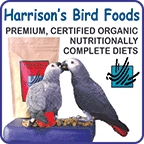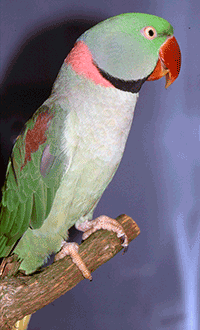 by Jim Hayward
by Jim Hayward
ORIGINAL HOMELAND:
A vast expanse of the near and far east, from Afghanistan through Pakistan, India, Ceylon, Burma, Thailand and on to Indo-China.
NATURAL HABITAT:
This adaptable species is to be found in a variety of habitats, from riverine forest, to arid thinly wooded country, from highland to lowland, from the vicinities of villages to the gardens and parks of towns.
STATUS IN THE WILD:
As common as to be seen in roosts numbering thousands in its strongholds, such as northern India, but sparsely represented at the peripheraries of its range.
STATUS IN AVICULTURE:
Always popular as pets since the days of Alexander the Great, nowadays becoming much more popular as a breeding aviary species.
LEVEL OF KEEPER'S EXPERIENCE:
Suitable for the novice with experience of keeping the smaller Indian Ringneck.
HARDINESS:
These parrakeets are known to be susceptible to frost bitten toes; apart from this, they are recognized as a hardy long lived species.
TYPE OF ACCOMMODATION:
It is a shame to keep a pair of such large and handsome parrakeets in a flight less than 15ft in length; the destructive habits of these birds dictate that the aviary must be strongly made to withstand their powerful mandibles, so wooden framework and thin mesh will be no obstacle whatever to the birds' escape - at least 16g welded mesh should be used and wooden framework covered with metal sheet or replaced by metal pipe or angle iron. A shelter is advisable.
TYPE OF DIET:
Seeds and grains; sunflower, safflower, mixed canary, mixed millet, maize, wheat, etc; a daily mixed portion of fruit and vegetable, apple, orange, grapes, berries, corn-on-the-cob, peas, celery, cabbage, carrot, cabbage, chickweed and other wild food as available. Wholemeal bread and milk, and germinated seed should be given during the breeding season; a lot of cuttlefish is eaten (or wasted) and should always be available.
SEXING:
Only cocks have black neck rings and pink collars, but both sexes have maroon shoulder patches. The tails of hens are shorter than those of the cocks, but those of immatures are still shorter.
SEXUAL MATURITY:
Alexandrines do not attain full adult plumage until they are three years old, and are likely to begin attempts to breed from three to four years old.
NESTING SEASON IN BRITAIN:
Breeding can commence as early as February or March but it may be wiser to hold them back til March or April - they are known to go to nest as late as June.
TYPE OF NEST:
Suitable nests measure 10" square by 18" to 24" deep; made of inch thick exterior plywood and reinforced at strategic points with metal to save frequent repair. Initial filler of crumbled rooted wood and soft sieved sand, with offcuts of wood placed inside which the hen will quickly reduce to nest litter.
USUAL NUMBER OF EGGS:
Two to four eggs are usual.
INCUBATION PERIOD:
Incubation takes 22/23 days.
USUAL NUMBER OF YOUNG:
Two to three.
FLEDGING AGE:
About seven weeks.
USUAL NUMBER OF CLUTCHES:
A single clutch per season is usual.
NESTING HABITS:
During courtship, the cock's display consists of exaggerated advances, bowing, stretching, twirling and eye flashing, with shoulders thrust out. Only the hen incubates.
SPECIAL CONSIDERATIONS:
As with Ringnecks and Plumheads, 'hens' of pairs purchased as 'true pairs' can prove to be cocks after moulting; it is unwise to purchase cocks with the expectation of easily finding spare hens.
NOISE FACTOR:
High pitched far carrying but cheerful calls; could upset close neighbours.
AVAILABILITY:
Generally available.
COLOUR VARIETIES:
The first Lutino is reputed to have been imported into England in 1923, the shoulder patches of the Green bird are altered to orange red in the Lutino; about the same time, the first Blue was also imported and small numbers of both varieties were bred up, only to be lost during the ensuing war years. Lutinos and Blues are still rarities but do exist, however, in some cases colour varieties have been introduced into the Alexandrine via hybridization with the Indian Ringneck.
BACK TO TOP
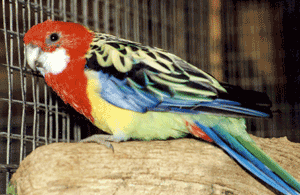 by Jim Hayward
by Jim Hayward
ORIGINAL HOMELAND:
There is a broad band of distribution of the Eastern Rosella on mainland Australia, from south-eastern South Australia, through Victoria into New South Wales; the brilliant Golden-mantled type becomes evident from the area of the Hunter River Valley in New South Wales and carries on northwards into south-eastern Queensland. The bulkier Tasmanian sub-species, with its larger white cheek patches, is confined to eastern areas of the island. Easterns have been introduced into New Zealand and populations exist on both North and South Islands.
NATURAL HABITAT:
This parrakeet lives in areas of open woodland, amongst trees adjacent to waterways; it is seen in orchards, parks and gardens and has actually benefited from the clearing of large areas of thicker forest for agricultural purposes - especially the areas set aside for growing of cereals.
STATUS IN THE WILD:
A common species.
STATUS IN AVICULTURE:
Widely bred and ever popular.
LEVEL OF KEEPER'S EXPERIENCE:
Suitable for novices with basic bird keeping experience.
HARDINESS:
Hardy and not prone to frost bite, but needs protection from cutting winds.
TYPE OF ACCOMMODATION:
An open fronted shelter with a flight measuring a minimum of twelve feet long by six feet high and three feet wide is suitable.
TYPE OF DIET:
The usual parrakeet seed mixture, plus fruit, greenfood, berries and budding branches, keeps them in good condition; softfood (canary rearing food and/or bread and milk) should be provided during the nesting and rearing period.
SEXING:
Easterns are easily sexed by the brighter and more sharply defined colours of the cock as opposed to the rather toned down colouration of the hen; the red on his head reaches further down the back of the neck than does that of the hen, and is sharply delineated at the point where it meets the black and yellow feathering. The bill and head of the cock is larger than that of the hen, as are the cheek patches; these differences can also be clearly seen even in fledglings.
SEXUAL MATURITY:
Both cocks and hens of only one year old - youngsters from a pair's first brood of the season - will attempt to breed, usually a week or more later than older adults.
NESTING SEASON IN BRITAIN:
From early spring to summer.
TYPE OF NEST:
A hanging nest-box measuring about seven inches square inside by around two feet high, set at a slight angle and fixed at head height under some cover is readily accepted.
USUAL NUMBER OF EGGS:
Though clutches of nine eggs and even more are known, five eggs is normal.
INCUBATION PERIOD:
Incubation takes eighteen or nineteen days.
USUAL NUMBER OF YOUNG:
Four to five is a good nest.
FLEDGING AGE:
The fledglings leave the nest when about five weeks old.
USUAL NUMBER OF CLUTCHES:
Can be double brooded.
NESTING HABITS:
In the wild, if hollow branches and trunks of trees are in short supply, they are willing to make do with rotting telegraph poles or stumps of fence posts; once possession is claimed the cock guards the site against other nest seekers, allowing the hen to complete her work in excavating and altering the entrance and hollow to her satisfaction. His aggressive actions towards interlopers include the tail wagging of the courtship ritual, rapid chattering and a thrusting forward of his shoulders with bill tucked into his throat feathers.
SPECIAL CONSIDERATIONS:
Non aggressive species must be chosen as neighbours; closely related parrakeets like other Rosellas and Redrumps will squabble, fight through the wire and disrupt breeding.
NOISE FACTOR:
Their calls are cheerful and musical, with only occasional louder alarm calls made when they are frightened.
AVAILABILITY:
Frequently offered for sale.
COLOUR VARIETIES:
Colour varieties have really taken off, with the Lutino, the Ruby (Red) and their combination the Rubino being highly popular; other varieties include Cinnamon, Pied, Dilute and - in Australia - Melanistic or Black.
BACK TO TOP
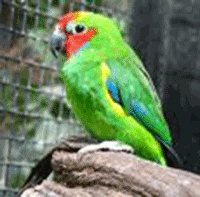 by Jim Hayward
by Jim Hayward
Opopsitta is often used instead of Cyclopsitta. Fig Parrots have also been called 'Dwarf Parrots' and 'Lorilets'.
ORIGINAL HOMELAND:
The nominate race is distributed through a large area of northern and southern parts of western New Guinea - as well as some coastal islands.
NATURAL HABITAT:
Forest and edges of forest, as well as isolated groves of trees.
STATUS IN THE WILD:
Common in its localities, moreso around the forested bases and sides of hills and mountains.
STATUS IN AVICULTURE:
An avicultural rarity; isolated consignments from Indonesia in the late 'seventies and early 'eighties have not resulted in the species becoming established.
LEVEL OF KEEPER'S EXPERIENCE:
Only the most advanced and dedicated parrot breeders should attempt to take on this difficult species - or any of the Fig Parrots for that matter.
HARDINESS:
Reported to be reasonably hardy once fully acclimatized - but who would be willing to risk a tiny bird of such delicate appearance to the rigours of a British winter?
TYPE OF ACCOMMODATION:
A birdroom with large inside flight cage/shelters attached to well protected outside flights, so that the birds may be allowed entrance to the outer aviaries and receive the benefit of sunshine and showers when the temperature is suitable.
TYPE OF DIET:
In the wild - though eating other fruits, seeds and berries - they are very specialised feeders and live mostly on the various species of small native figs, choosing the tiny seeds and generally discarding any fleshy parts. They also feed off blossoms, taking nectar and insects, will excavate and tear apart rotten wood to get at insects, larvae and grubs, and have been seen eating rotten wood, fungus and lichen attached to bark. In aviculture a wide variety of foods is essential, from small and large seeds (including millet, canary, safflower and sunflower), to a wide variety of vegetables and fruits (including figs, apple, banana, papaya, carrot, kiwi, grapes, cherries, soft and hard berries, milky corn, sweet potato, peas, germinated mung beans). Insectivorous and canary rearing food is important (with boiled egg yolk mixed in), livefood must be provided - as well as nectar. Rotten stumps of wood to gnaw appear to be an important addition to the digestive process.
SEXING:
The red on the cheeks of cocks is replaced by a buffish colour in hens; immatures lack the red cheeks and have paler bills, they take about a year to acquire full adult appearance.
SEXUAL MATURITY:
Not known, but probably mature at around a year old.
NESTING SEASON IN BRITAIN:
According to the few reported breedings in Europe, nesting has commenced in summer, with young fledging as late as early autumn.
TYPE OF NEST:
In the wild, these strong billed little parrots bore an entrance hole and excavate a shallow hollow (around 3 1/2" to 4" in diameter and depth) out of rotten trunks and branches; there is no distinction between vertical and horizontal branches and they tend to excavate subsequent nests close by the old one.
USUAL NUMBER OF EGGS:
Two.
INCUBATION PERIOD:
18 to 19 days.
USUAL NUMBER OF YOUNG:
One, sometimes two.
FLEDGING AGE:
Between five and six weeks.
USUAL NUMBER OF CLUTCHES:
Two and sometimes three nests can be attempted in succession.
NESTING HABITS:
Only the hen incubates. The work of excavation done by the hen is important for the breeding process, and success has been achieved by breeders providing un-worked rotten logs as nests.
SPECIAL CONSIDERATIONS:
Living as they do in the dense forest canopy, a large open space aviary can confuse them with the result that they can crash into the wire and frame and damage themselves.
NOISE FACTOR:
High pitched calls and chatterings.
AVAILABILITY:
Seldom - if ever - available to general aviculture in these days.
BACK TO TOP
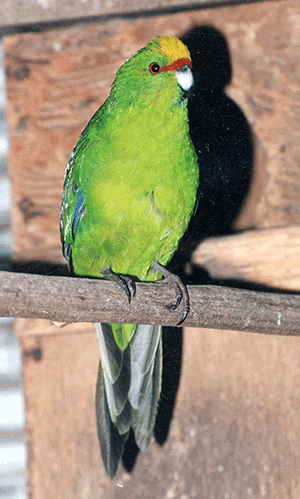 by Jim Hayward
by Jim Hayward
ORIGINAL HOMELAND:
New Zealand.
NATURAL HABITAT:
To be found in forested areas on both North and South Islands, as well as the offshore islands - including Auckland and Stewart.
STATUS IN THE WILD:
Said to be in decline on New Zealand itself due to destruction of the native forest and predation by introduced rats and cats since the early days of European settlement, but thriving on some of the offshore islands.
STATUS IN AVICULTURE:
Established, but nothing like as common as the Red-fronted Kakariki.
LEVEL OF KEEPER'S EXPERIENCE:
Previous experience in breeding any of the smaller Australian parrakeets is sufficient.
HARDINESS:
Reasonably hardy, it has a thick underdown which gives good insulation against our winters; these birds are used to a cooler, damper climate than most Australian species.
TYPE OF ACCOMMODATION:
A flight measuring 3ft wide, 6ft high and from 6ft to 12ft in length is ideal. The aviary should be sheltered from strong winds and driving rain or snow. An open fronted shelter is sufficient protection, but an enclosed shelter is a benefit for all parrakeets.
TYPE OF DIET:
As well as a good parrakeet seed mix(sunflower, safflower, canary mix, various millets), greenfood, fruit and berries, should be included in their diet, as well as some soft food (canary egg food, bread and milk) and a few mealworms.
SEXING:
The cocks have noticeably larger heads and bills in comparison with hens.
SEXUAL MATURITY:
Though they will breed as early as four to six months old, it is best to dissuade them from nesting until the year following that in which they were hatched.
NESTING SEASON IN BRITAIN:
Kakarikis are likely to go to nest at any time of year, but the box should be removed during the winter and nesting held back until the longer and warmer days of spring and summer when their efforts will be more rewarding.
TYPE OF NEST:
A suitable nestbox would measure around 7" square by 15" high.
USUAL NUMBER OF EGGS:
Whereas the clutch of eggs of the Red-fronted is usually large and seven or more can be expected, Yellow-fronteds usually average smaller clutches of five or six.
INCUBATION PERIOD:
18/19 days.
USUAL NUMBER OF YOUNG:
Three to five.
FLEDGING AGE:
Just over five weeks.
USUAL NUMBER OF CLUTCHES:
Two clutches per season can be expected, a third is a bonus but further nests debilitate the breeding birds.
NESTING HABITS:
As soon as a nest is hung up, the hen takes to roosting in it every night. Fledged birds should be removed from the aviary as soon as they can feed - bullying by the parents can lead to deaths.
SPECIAL CONSIDERATIONS:
Hybridization with the commoner Red-fronted Kakariki has been frequent, and specimens should not be purchased for use as breeding stock.
NOISE FACTOR:
The sound of their voices is not loud or offensive and consists of pleasant chatterings and the characteristic 'bleating' calls.
AVAILABILITY:
Though obtainable, pure bred birds are not offered for sale as often as they were a few years ago.
COLOUR VARIETIES:
There is a Yellow variety which is still rare at present.
BACK TO TOP
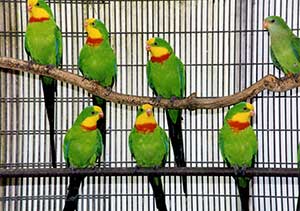 by Jim Hayward
by Jim Hayward
ORIGINAL HOMELAND:
Two limited ranges in New South Wales and Victoria.
NATURAL HABITAT:
They mostly prefer to live where trees line the banks of waterways, though forested areas are acceptable. Though they take food from the ground, their liking for blossom and nectar causes them to wander in search of flowering Eucalypts.
STATUS IN THE WILD:
Thought at one time to be on the decrease, the spread of agriculture, and the increase in irrigation which this requires, seems to have been of benefit to this species.
STATUS IN AVICULTURE:
A deservedly ever popular and long established species in British aviculture.
LEVEL OF KEEPER'S EXPERIENCE:
The keeping and breeding of any of the commonest Australian Parrakeets should provide sufficient experience for the general management of the Barraband.
HARDINESS:
Sufficiently hardy to withstand wintering out with just an open fronted shelter in all but the most exposed areas and northerly parts of the British Isles.
TYPE OF ACCOMMODATION:
Though they will thrive and breed in aviaries measuring only 9ft in length, these swift flying birds are at their best in an enclosure of 18ft or longer. They are not destructive to wood or wire mesh.
TYPE OF DIET:
All they need is a standard parrakeet mixture (sunflower, safflower, canary mixture, millet, and millet sprays), greenfood (the usual seeding grasses and plants) and some chopped fruit and vegetable mixture. Bread and milk and/or canary rearing food can be offered and is especially useful when the birds have young; germinated seed can be given but care must be taken to see that it is perfectly fresh or serious infections can result. As always, water must be kept fresh and cuttlefish bone available at all times.
SEXING:
In most strains of Barraband's the grey cast over hens' faces has a bluish or slate tinge, but in some breeding stocks young hens have a faint wash of brown. By autumn the eyes become lighter in both sexes, but the irides of young cocks are paler and - by this time - tending towards yellow, and their upper mandibles are becoming more pink. Red flecks and yellow dabs begin to appear on the faces of young immature cocks as early as the winter following the spring in which they were hatched, though may not show in some specimens until they are almost a year old. Fledgling Barraband's can be sexed by their appearance as long as there is a sufficient number of nest-mates to compare. Some of the young may have a trace of red across the throat and these can be quickly regarded as cocks; others may have a greyish cast to the face, forehead and throat and these are most likely to be hens. Youngsters with a brownish tinge across the throat and a yellowish cast over the green of the face and forehead can be reasonably assumed to be cocks.
SEXUAL MATURITY:
They do not usually show serious inclination towards nesting until in their third year.
NESTING SEASON IN BRITAIN:
Nesting usually commences between April and early June.
TYPE OF NEST:
A hanging box measuring 8-9 inches square inside by 18 inches deep, fixed from waist to head height is generally accepted.
USUAL NUMBER OF EGGS:
The usual clutch of eggs varies between four and six.
INCUBATION PERIOD:
Incubation is around 18 days.
USUAL NUMBER OF YOUNG:
Two to four is usual.
FLEDGING AGE:
Just over five weeks.
USUAL NUMBER OF CLUTCHES:
Though in my experience these parrakeets are not double brooded, a good breeding pair is likely to be the most dependable rearers in a parrakeet specialist's collection, producing a yearly brood of young well into their second decade. They can also be persuaded to act as foster parents for other similar sized parrakeets and even for species larger than themselves.
NESTING HABITS:
Though it is recommended that they be kept one breeding pair to a flight, it is possible to keep a group together as the cocks are quite amenable to each other. However, successful nesting is far less likely as all the cocks will chase around after any hen which leaves the nest - and this means that successful mating is less likely. As a general rule, they are the most placid of neighbours and for this reason are ideal to place alongside pairs of more quarrelsome Australians such as Rosellas or Red-rumps.
SPECIAL CONSIDERATIONS:
On average, birds of this genus are more susceptible to partial paralysis of the legs and eye infection as a legacy of serious illness than - for example - Rosellas (Platycercus). But if the management is correct and the initial stock is strong, illnesses should be rare.
NOISE FACTOR:
They have cheerful chirruping calls, but this should not worry any reasonable neighbours.
AVAILABILITY:
Some can usually be seen advertised for sale at most times of the year.
COLOUR VARIETIES:
As far as is known, none so far - but both a Blue and a Lutino variety would be exceptionally beautiful.
BACK TO TOP
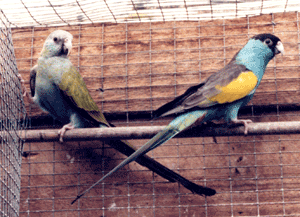 by Jim Hayward
by Jim Hayward
ORIGINAL HOMELAND:
The north east sector of Northern Territory, Australia.
NATURAL HABITAT:
Dry wooded grassland, with terrestrial termite mounds.
STATUS IN THE WILD:
In decline; on CITES schedule 1 of endangered parrots.
STATUS IN AVICULTURE:
Well established.
LEVEL OF KEEPER'S EXPERIENCE:
Knowledgeable aviculturists, well practiced in breeding the common Psephotus and/or Neophema parrakeets. HARDINESS: Latter day strains are more tolerant of winter conditions, previously these birds would be kept in enclosed aviaries during our autumn and winter and allowed out in spring and summer.
TYPE OF ACCOMMODATION:
Access to flights of around 10ft in length, these being attached to birdroom shelters which are large enough in which a breeding pair could be confined when the weather is obviously affecting them, or during the nesting cycle - if need be. Wooden frame and 19g wire mesh is sufficient.
TYPE OF DIET:
Small seeds are preferred (canary mixture, millet mixture, millet spray) with only a small amount of sunflower and safflower. Seeding grasses, seeding chickweed and germinated seed is most important during the breeding season; soft food such as canary egg food and bread and milk when nesting.
SEXING:
Cocks and hens are very different in colour, the obvious differences being the hen's lack of the cock's black mask and crown, golden yellow wing patch, dark back and flights, and brilliant deep turquoise body and face. Immatures carry the hen's subdued colours.
SEXUAL MATURITY:
Year old birds will attempt to breed.
NESTING SEASON IN BRITAIN:
Usually from late summer through autumn, though some breeders have reported spring breedings.
TYPE OF NEST:
It is usual to provide a plywood nest-box (about 5 1/2" square inside by 15" deep) which can be kept at a pleasantly warm temperature with either a heating pad in the base, or a light bulb placed by the side of the nest; in the early days hens could not be depended upon to keep the nestlings warm, but indications in recent years show that more hens are acquiring the instinct of brooding their young until they are almost feathered.
USUAL NUMBER OF EGGS:
Four to five.
INCUBATION PERIOD:
21 days.
USUAL NUMBER OF YOUNG:
Three to four.
FLEDGING AGE:
About five weeks.
USUAL NUMBER OF CLUTCHES:
Can be double brooded.
NESTING HABITS:
In the wild they burrow a tunnel and nest chamber in terrestrial termite nests.
SPECIAL CONSIDERATIONS:
Watch for over eager cocks driving their hens until they retaliate, a belligerent hen will turn a skirmish into a battle.
NOISE FACTOR:
They have pleasant quiet voices which could give no offence.
AVAILABILITY:
Always in demand, sometimes advertised but wise to reserve birds from a breeder.
COLOUR VARIETIES:
'Yellow' examples are said to exist, probably a Dilute variety.
BACK TO TOP
 by Jim Hayward
by Jim Hayward



 by Jim Hayward
by Jim Hayward by Jim Hayward
by Jim Hayward
